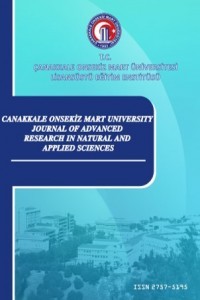Yeni Bir Katalizörün İki Farklı Reaktör Tarafından Elde Edilen Piroliz Verimine Etkisi
Bu çalışmada polimer ve selüloz içerikli biyokütle malzemeleri, iki farklı katalizör (sepiyolit ve alüminyum boksit) kullanımında ve oksijensiz bir ortamda piroliz edilmiştir. Piroliz işlemleri döner yataklı piroliz reaktör (DYR) ve sabit yataklı reaktör (SYR) olmak üzere iki ayrı reaktörde gerçekleştirilmiştir. Çalışmada biyokütle içeriği bileşen oranları, iki farklı katalizörün aynı oranlarda katılması ve farklı tip reaktör kullanımı gibi parametrelerin son ürüne etkileri belirlenmiştir. Öncelikle belirli oranlarda polimer ve selüloz içeren biyokütle karışımları hazırlanmıştır. Ardından ısıl aktif katalizörler biyokütle karışımlarına eklenmiştir. Deneylerin sonunda elde edilen katı ve sıvı son ürünlerin üst ısıl değer (HHV), element içeriği, parçacık boyutları ve yüzey alanı ölçüm değerleri hesaplanmış ve analiz edilmiştir. DYR ve SYR reaktörlerinden boksit katalizörlüğünde elde edilen sıvı ürünlerin HHV değerleri sırası ile 42,74 MJ/kg ve 40,95 MJ/kg olarak bulunmuştur. Bunun yanında DYR ve SYR reaktörlerinden sepiyolit katalizörlüğünde elde edilen sıvı ürünlerin HHV değerlerinin ise 41,28 MJ/kg ve 38,94 MJ/kg değerlerinde olduğu görülmüştür. Bu değerlerin günümüzde de yaygın olarak kullanılan geleneksel dizel yakıtın HHV değerine (42,7 MJ/kg) oldukça yakın olduğu görülmektedir. Buna karşın elde edilen katı numunelerin HHV değerlerinde kayda değer bir farklılık görülmemiştir. Diğer yandan katı numunelerin SEM görüntüleri incelendiğinde SYR ile kıyasla DYR de gerçekleşen biyokütle karışımlarının pirolizinde daha iyi performans gösterdiği anlaşılmaktadır.
Anahtar Kelimeler:
Kalorimetre, katalizör, enerji dönüşümü, daha yüksek ısıtma değeri, piroliz
Influence of A Novel Catalysis on The Pyrolysis Yields Obtained by Two Different Reactors
In the present study mixtures of polymeric and cellulosic biomass materials were pyrolized in the presence of two different catalysts (sepiolite and aluminium bauxite) in various ratios by two different reactors; a rotary kiln reactor (RKR) and a fixed bed pyrolysis reactor (FBR). The results were compared to determine the effects of pyrol-ysis parameters such as catalysts, feedstock and reactor types on the energy content of the final products. First, the polymeric and cellulosic materials were mixed at certain ratios and thus the mixtures were prepared. Then, thermally activated catalysts were added to these mixtures. At the end of the experiments, certain properties such as higher heating value (HHV), the elemental concentrations, particle size and size surface areas of the end products (for solid and liquid phases) were calculated and analysed. The HHV of the liquid products from bauxite added mixture in RKR and FBR was 42.74 MJ/kg and 40.95 MJ/kg respectively. Besides the HHV of the oil products from sepiolite added mixture in RKR and FBR was 41.28 MJ/kg and 38.94 MJ/kg respectively. These values are same and close to HHV of the conventional diesel (42.7 MJ/kg). However no considerable effect seen on HHV of char products from catalyst added mixtures. On the other hand, due to the SEM images the char products it can be clearly concluded that com-paring with FBR, RKR had the better performance on pyrolysis of the biomass mixtures.
Keywords:
Calorimeter, catalyst, energy conversion, higher heating value, pyrolysis,
___
- Anca-Couce, A., Mehrabian, R., Scharler, R., & Obernberger, I. (2014). Kinetic scheme of biomass pyrolysis considering secondary charring reactions. Energy Conversion and Management, 87, 687–696. doi: 10.1016/j.enconman.2014.07.061
- Chattopadhyay, J., Pathak, T. S., Srivastava, R., & Singh, A. C. (2016). Catalytic co-pyrolysis of paper biomass and plastic mixtures (HDPE (high density polyethylene), PP (polypropylene) and PET (polyethylene terephthalate)) and product analysis. Energy, 103, 513–521. doi: 10.1016/j.energy.2016.03.015
- Foster, A. J., Jae, J., Cheng, Y. T., Huber, G. W., & Lobo, R. F. (2012). Optimizing the aromatic yield and distribution from catalytic fast pyrolysis of biomass over ZSM-5. Applied Catalysis A: General, 423–424, 154–161. doi: 10.1016/j.apcata.2012.02.030
- Haykiri-Acma, H., Yaman, S., & Kucukbayrak, S. (2006). Effect of heating rate on the pyrolysis yields of rapeseed. Renewable Energy, 31(6), 803–810. doi: 10.1016/j.renene.2005.03.013
- Lédé, J. (2013). Réacteur de pyrolyse rapide de la biomasse: Une revue de quelques verrous scientifiques et d’actions de recherches recommandées. Oil and Gas Science and Technology, 68(5), 801–814. doi: 10.2516/ogst/2013108
- Montoya, J. I., Valdés, C., Chejne, F., Gómez, C. A., Blanco, A., Marrugo, G., Osorio, J., Castillo, E., Aristóbulo, J., & Acero, J. (2015). Bio-oil production from Colombian bagasse by fast pyrolysis in a fluidized bed: An experimental study. Journal of Analytical and Applied Pyrolysis, 112, 379–387. doi: 10.1016/j.jaap.2014.11.007
- Roy, P., & Dias, G. (2017). Prospects for pyrolysis technologies in the bioenergy sector: A review. Renewable and Sustainable Energy Reviews, 77, 59–69. doi: 10.1016/j.rser.2017.03.136
- Salan, T. (2014). Catalytic Pyrolysis Of Pulper Rejects. Kahramanmaras Sutcu İmam University.
- Sebestyén, Z., Barta-Rajnai, E., Bozi, J., Blazsó, M., Jakab, E., Miskolczi, N., & Czégény, Z. (2017). Catalytic Pyrolysis of Biomass and Plastic Mixtures Using HZSM-5 Zeolite. Energy Procedia, 105, 718–723. doi: 10.1016/j.egypro.2017.03.381
- Stefanidis, S. D., Kalogiannis, K. G., Iliopoulou, E. F., Michailof, C. M., Pilavachi, P. A., & Lappas, A. A. (2014). A study of lignocellulosic biomass pyrolysis via the pyrolysis of cellulose, hemicellulose and lignin. Journal of Analytical and Applied Pyrolysis, 105, 143–150. doi: 10.1016/j.jaap.2013.10.013
- Tripathi, M., Sahu, J. N., & Ganesan, P. (2016). Effect of process parameters on production of biochar from biomass waste through pyrolysis : A review. 55, 467–481.
- Wan, K., Wang, Z., He, Y., Xia, J., Zhou, Z., Zhou, J., & Cen, K. (2015). Experimental and modeling study of pyrolysis of coal, biomass and blended coal-biomass particles. Fuel, 139, 356–364. doi: 10.1016/j.fuel.2014.08.069
- Zhou, L., Yang, H., Wu, H., Wang, M., & Cheng, D. (2013). Catalytic pyrolysis of rice husk by mixing with zinc oxide: Characterization of bio-oil and its rheological behavior. Fuel Processing Technology, 106, 385–391. doi: 10.1016/j.fuproc.2012.09.003
- Yayın Aralığı: Yılda 4 Sayı
- Başlangıç: 2015
- Yayıncı: Çanakkale Onsekiz Mart Üniversitesi
Sayıdaki Diğer Makaleler
Algol-türü Örten Çift UU And'ın O-C Analizi
Yeni Bir Katalizörün İki Farklı Reaktör Tarafından Elde Edilen Piroliz Verimine Etkisi
Mert KILINÇEL, Ethem TOKLU, Fikret POLAT
Nuray YAVUZKANAT, Hazal Burcu SARAÇ KÜREM
Deniz Ekosisteminde Bakteriyel Roller; Türkiye Denizleri Bakterileri Örneği
Gülşen ALTUĞ, Mine ÇARDAK, Pelin Saliha ÇİFTÇİ TÜRETKEN, Sevan GÜRÜN, Samet KALKAN
Yakıt Tankları İçin Bir Stok Yönetimi ve Sızıntı Tespit Sistemi
Ayşe Nur DALMAN, Murat Oluş ÖZBEK
